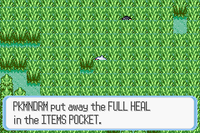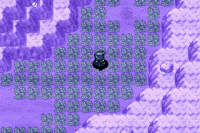Tall grass: Difference between revisions
Tiddlywinks (talk | contribs) (→Determining the rate of encounter: Only one equation should be needed. The rest wasn't worded well (and for the life of me, this is the only thing I can figure it must have meant)) |
|||
| Line 88: | Line 88: | ||
==Technical mechanics== | ==Technical mechanics== | ||
===Determining the rate of encounter=== | ===Determining the rate of encounter=== | ||
The | The probability (''P'') of encountering a Pokémon after taking a step in an area is determined by a simple mathematical formula: | ||
<big>''P = x / 187.5''</big> | |||
<big>''P = x / 187.5 | |||
where ''x'' is one of the values below describing how rare Pokémon are in the area. | |||
{| class="roundy" style="text-align:center; background: #{{locationcolor/dark|land}}; border:3px solid #{{locationcolor/light|land}};" | {| class="roundy" style="text-align:center; background: #{{locationcolor/dark|land}}; border:3px solid #{{locationcolor/light|land}};" | ||
|- | |- | ||
! | ! style="background: #{{locationcolor/med|land}};; {{roundytl|5px}}" | Encounter rarity | ||
! style="background: #{{locationcolor/med|land}}; {{roundytr|5px}}" | ''x'' | |||
|- style="background: #fff" | |- style="background: #fff" | ||
| Very common | | Very common | ||
Revision as of 13:49, 6 April 2014
Tall grass is a mechanic in the Pokémon core series, and the habitat for many species of wild Pokémon. By entering patches of tall grass, a wild Pokémon may appear and begin to battle the player.
Tall grass is found on most routes of the Pokémon world, with some routes containing more tall grass patches than others. If the player enters a patch of tall grass, they may randomly enter a wild Pokémon battle. People are warned to stay out of tall grass if they don't have a Pokémon, due to the possibility of being attacked by wild Pokémon.
In Generation I and Generation II, using Cut causes a map tile composed of four walkable tiles of tall grass to be cut down directly in front of the player. In Generation III, this instead erases a 3×3 area around the player. In Generation II, long grass, such as that in the National Park, would be cut down gradually, while in Generation III, it is instantaneous. From Generation IV onwards, Cut has no effect on tall grass.
Differences between games
|
Technical mechanics
Determining the rate of encounter
The probability (P) of encountering a Pokémon after taking a step in an area is determined by a simple mathematical formula:
P = x / 187.5
where x is one of the values below describing how rare Pokémon are in the area.
| Encounter rarity | x |
|---|---|
| Very common | 10 |
| Common | 8.5 |
| Semi-rare | 6.75 |
| Rare | 3.33 |
| Very rare | 1.25 |
Poké Radar
- Main article: Poké Radar
The Poké Radar is a device introduced in Generation IV that is used to seek out wild Pokémon hiding in long grass. If the Pokémon that is found is knocked out or captured in a Poké Ball, a chain will begin. These chains consist of multiple members of the same Pokémon species encountered one after another. The only catch is this: a player must not encounter any Pokémon just by walking through non-wiggling grass, only by walking into the grass that shakes. Therefore, it is recommended that Repel is used in order to ensure this and achieve a higher chain. Entering the same type of grassy patch the chain was started in that is the farthest away increases the chances of meeting the same kind of Pokémon consecutively. Long chains increase the chance of finding a Shiny Pokémon, which is indicated by the patch of grass glowing white twice rather than shaking. In Generation IV, long grass does not shake when the Poké Radar is used.
Alternative areas

|
This section is incomplete. Please feel free to edit this section to add missing information and complete it. Reason: Long rustling grass; tall flowers |
Long grass
Some areas in the Pokémon world have larger patches of grass than usual. These patches of grass have grown longer and more widespread than the usual grass patches, hiding many different species of Pokémon. Up until Generation VI, it was impossible to ride a bicycle through this type of grass (and impossible to run through it in Generation III). Some Trainers hide in the long grass patches, concealing themselves from view and surprising the player to a battle. Long grass was introduced in Generation II, where it was found in Johto's National Park. In Generation III, it is found on Route 119 and Route 120, in Generation IV on Route 210, in Generation V, on Route 7, and in Generation VI, on Route 6 and Route 16.
In Generation V, long grass can be normal or dark, and behaves just like standard grass: normal grass can rustle, while in dark grass, double wild encounters may occur.
|
Seaweed
Seaweed, found only in Generation III, is located underwater in Pokémon Ruby, Sapphire, and Emerald, as an underwater equivalent to tall grass on land. Seaweed can be found while using Dive on dark patches of water on Route 124 and Route 126. The chance of encountering Pokémon in seaweed is lower than that of tall grass.
|
Dark grass
This type of grass is exclusive to Generation V. In dark grass, not only are Pokémon found usually at much higher levels than those in regular grass, but there is a chance of encountering two wild Pokémon at a time, in a Double Battle. Pokémon encountered in dark grass are often similar to those found in normal grass areas of the route, but not identical (in particular, Pokémon encountered in dark grass may be slightly more difficult to catch). Often, Pokémon which are rare in normal grass are more common in dark grass.
Patches of dark grass are typically separated from patches of normal grass. Dark grass does not rustle. There is also long dark grass, which behaves like both types of grass simultaneously.
|
Rustling grass
- Main article: Phenomenon
Rustling grass is found in Generation V, in virtually any area with patches of tall grass. Occasionally, a patch of grass can be seen shaking. Entering such a patch triggers a battle with a wild Pokémon. The Pokémon found in rustling grass differ from route to route, but all areas (except Route 19) contain Audino. In most areas, it is possible to encounter in rustling grass the evolved forms of Pokémon found in regular grass. Regular tall grass has a chance to start rustling for every step the player takes. Rustling grass will stop shaking if the player enters a battle, or if they leave the area (even if that specific grass patch remains on the screen). Dark grass does not rustle.
|
Flowers
Generation VI introduces flowers as an alternate grass tile. Flowers may be found on Routes 4, 7, 8, 10, 12, 15, 16, 18, 19, 20, 21, and 22, along with the Pokémon Village, and can be yellow, red, or purple. The Pokémon that can be found in one color of flowers may be different than those found in another color or in tall grass; especially with Flabébé (whose flower generally matches which patch it is found in).
In battle
In Generation III, using Secret Power in tall grass gives the move a 30% chance of poisoning its target, and depicts it with the appearance of Needle Arm; it causes Nature Power to become Stun Spore. Long grass gives Secret Power a 30% chance of putting its target to sleep, and gives it the appearance of Magical Leaf; it causes Nature Power to become Stun Spore. Seaweed gives Secret Power a 30% chance of lowering its target's Defense, and gives it the appearance of Waterfall; it causes Nature Power to become Hydro Pump.
In Generation IV and V, tall grass gives Secret Power a 30% chance of putting its target to sleep, and gives it the appearance of Needle Arm; it causes Nature Power to become Seed Bomb.
In Generation VI, tall grass gives Secret Power a 30% chance of putting its target to sleep, and gives it the appearance of Vine Whip; it causes Nature Power to become Energy Ball.
Camouflage makes the user Grass-type when used in grass, and Water-type when used in seaweed.
| Special tiles in the Pokémon games |
|---|
| Cave tile • Hole • Ice tile • Ledge • Marsh tile • Puddle • Sand tile • Snow tile Spin tile • Soft soil • Tall grass • Trap • Warp tile • Water tile Dungeon tile |

|
This game mechanic article is part of Project Games, a Bulbapedia project that aims to write comprehensive articles on the Pokémon games. |



